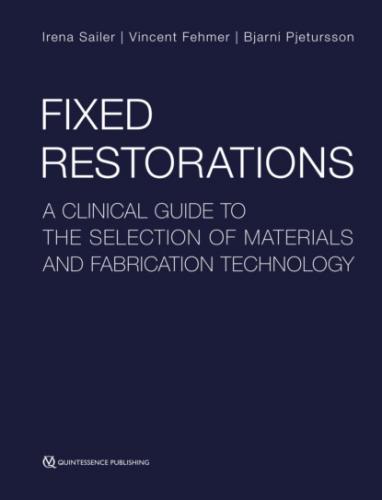Fixed Restorations. Irena Sailer
and money in elaborating the pretreatment diagnostics the first important desires can already be defined. The virtual mock-up is superimposed live on the patient’s face, while following all live movements of the lips, face, and head giving a natural appearance (Fig 1-4-8). The software automatically recognizes the correct position of the virtual teeth onto the natural teeth and within the face, without any need for reference points, which normally need to be defined for the super-imposition of 3D data and facial scans19. The appearance is similar to looking into a mirror while changing different virtual mock-ups and thereby dental looks, and serves for communication and planning purposes.
Figs 1-4-8a to 1-4-8c Before and after insertion of selected diagnostic mock-up (reproduced from Sancho-Puchades et al16, with permission).
Figs 1-4-8d to 1-4-8h Situation before treatment, three different mock-ups, and final restoration (reproduced from Sancho-Puchades et al16, with permission).
As indicated before, the presented app is using facial recognition (FR) and augmented reality (AR). FR describes a technology capable of automatically identifying a person from a digital image, using reference lines of the face and mathematical algorithms20,21. AR is a type of technology in which an environment is enhanced through the process of superimposing computer-generated virtual content over a real structure18,22. Even if AR tools were mainly used for video games and animations, the medical field is working to integrate these technologies for diagnosis, surgery, education, and communication with patients23.
To date, this new technology serves for communication purposes only, yet, in the future its utility will certainly be expanded. As an example, the selected virtual solution may be exported from the app as an open .STL file, to be imported onto CAD or guided surgery software. The file may, hence, serve for the planning and execution of the respective treatment steps without further need of development of the virtual diagnostics by the dental technician. With this, time and efficiency may be increased, in line with the predictability of the treatment.
Furthermore, with aid of the exported selected virtual solution and its import into other digital files of the patients, eg, cone beam computed tomography (CBCT), the clinician can analyze whether or not anatomic limitations exist, and if pretreatment (eg, orthodontics) may be recommended in order to fulfill the patient expectations. The software may even be used to indicate solutions for compromise in such situations. As all these developments are just in their early days, they will need to further evolve in the years to follow.
Their current application is highlighted in Part II, Chapter 8 (Special indications) of this book.
1.4.7 Diagnostics for fixed implant-supported restorations, surgical stents
The 3D implant position is associated with the esthetic outcome of the implant-borne restorations and the associated soft tissue outcomes24. In the past, the pretreatment diagnostics and planning of dental implants were mainly based on stone casts and 2D radiographs. Clinical structures such as the crowns of adjacent teeth, soft tissue margins, and tooth axes were used as orientation landmarks, and a template with composite resin simulating the future crown served as a drilling guide as well as a later means of assessing the 3D position of the implant. Radio-opaque templates made using radio-opaque composites allowed for the preliminary transfer of information from diagnostic radiographs (Fig 1-4-9).
Figs 1-4-9a to 1-4-9g Step-by-step procedure at a conventional implant planning including a 2D radiographic analysis, manual diagnostic wax-up, and fabrication of a conventional surgical stent. The conventional surgical stent helps defining the best 3D prosthetically oriented position of the implant.
Today, 3D digital imaging technologies such as computed tomography (CT) (previously used), and CBCT (more recently used) make it possible to plan and carry out the positioning of dental implants using appropriate 3D positioning software, and to transfer the information from the 3D imaging datasets to the surgical guides. These technological advances have increased the safety of dental implants, especially when placed in narrow spaces or in close proximity to critical anatomical structures (Fig 1-4-10).
Figs 1-4-10a and 1-4-10b CBCT for the 3D evaluation of the bony situation and the proximity to critical anatomical structures (eg, the maxillary sinus), crucial for the implant planning.
The 3D implant position is, hence, a crucial factor for the esthetic outcome of the implant restoration. Furthermore, it can influence the biologic and functional outcomes. The Consensus Conference of the 11th European Workshop on Periodontology thus issued a consensus statement on the primary prevention of peri-implantitis, which includes the following recommendations25: (1) implant placement must allow for proper personal cleaning; and (2) the superstructure must allow for good hygiene, ie, it must be free of niches and undercuts that can cause tissue trauma. Reviews of the literature have shown that the different types of superstructure fixation (cemented versus screw-retained) were associated with different rates of functional and biologic complications26. Cement excess with cemented restorations induces specific biologic risks and can play a role in the etiology and pathogenesis of peri-implantitis27,28.
Therefore, dental implant planning must always start with the diagnostic determination of the foreseen restoration, both in posterior and anterior regions. The 3D position of an implant
